From Trial Delays to Smart Decisions: How Agentic AI In Life Sciences Is Redefining Innovation
This blog will examine the primary challenges that pharmaceutical businesses must overcome to comprehend how agentic AI in Life Sciences industry might help them maximize efficiency and increase the likelihood that their products will be developed and successfully commercialized.
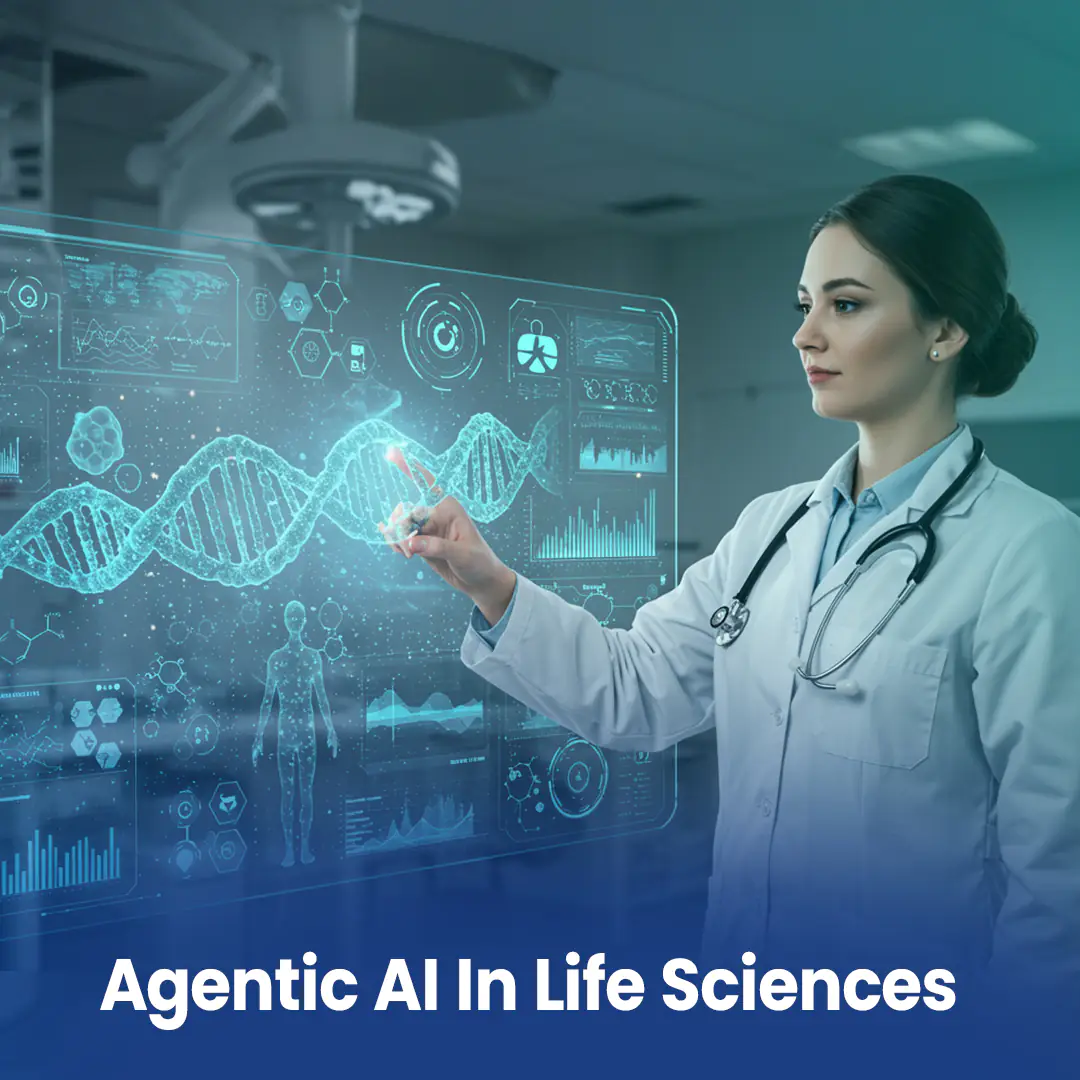
Delays From Manual Data Entry and Errors? We Build Smart Platforms to Automate Clinical Data Capture

“Agentic AI, characterized by its capacity for autonomous task execution rather than mere assistance, heralds a fundamental paradigm shift in biopharmaceutical operations. From accelerating discovery and streamlining development to revolutionizing commercialization and governance, agentic AI systems are poised to redefine the industry’s core processes.”– NCBI
Why Agentic AI is Key for the Future of the Life Sciences Industry
Agentic AI in life sciences is essential to remain inventive and competitive in the coming years. Traditional processes are unable to keep up with the industry’s growing demands to save costs, expedite drug development, customize therapy, and negotiate ever-more difficult regulatory frameworks. Investors have invested over $2 billion in agentic AI firms in the last two years, according to Deloitte, with a particular emphasis on enterprise-focused solutions.
By automating multi-step procedures, coordinating data across silos, and dynamically adjusting to changing requirements, agentic AI provides a radically novel approach to scaling expertise. Whether it’s expediting regulatory filings or improving clinical trial design, agentic AI provides the speed, adaptability, and intelligence required to succeed in this rapidly changing, data-rich environment. Businesses that adopt these skills will not only become more efficient in their operations but also open completely new avenues for innovation and patient benefit.
What Generative AI and Agentic AI in Life Sciences Can Accomplish
Life sciences organizations soon discovered that not all tasks are appropriate for LLMs or autonomous agents, despite the initial excitement that put Gen AI at the forefront of almost every business discussion. The greatest achievements so far typically center on use cases where:
- Manual effort is costly.
- Speed and consistency are just as important as creativity.
- Current regulatory and quality frameworks can flex to support AI outputs.
- Works with large volumes of structured and semi-structured data.
We have already witnessed Gen AI and agentic AI transform several aspects of the life sciences, with pharmacovigilance and safety operations being particularly successful. AI has also been utilized in post-call CRM analysis for message refining, commercial field enablement, qualitative market research analysis, and syndicated data exploration and reporting.
Every success story has one thing in common: a meticulous matching of an actual business problem with the appropriate AI capabilities.
Where do Agentic AI and Generative AI Scale Best?
The goal of scaling Gen AI and agentic AI is to use AI intelligently, not to apply it everywhere. Scaling in the life sciences typically occurs more quickly when:
- The task is intricate but repetitive. While traditional automation suffers with nuance, AI thrives when there is enough structure to learn from.
- It is possible to check and fix the output. The ease of auditing and reviewing AI-generated outputs is crucial, particularly in regulated businesses.
- Users gain instant advantages. If a field representative can save 30 minutes before each call using an AI tool, adoption will soar.
Gen AI and AI agents become more than just “nice to haves” when these prerequisites are met; they become necessary.
Operational Bottlenecks Slowing Down the Life Sciences Industry
Pharmaceutical manufacturers are under increasing pressure to boost production as new therapies are developed. The need for more flexible and effective production techniques is growing since the demand for these treatments is growing faster than conventional capacity expansion. However, several enduring, systemic issues are making it increasingly difficult for manufacturers to accomplish these objectives, including:
- Increased Manufacturing Complexity: To meet the demands of complicated products like personalized medications, which call for specialized procedures and technology, pharmaceutical companies are under increasing pressure to offer therapies more quickly.
- Fragile Global Supply Chains: With material shortages and delays endangering production schedules and patient access, global supply chains are still susceptible to disruption.
- Regulatory Complexity: Entering new markets requires negotiating varying regulations set forth by different authorities, which can make production more difficult and cause approvals to be delayed.
- Manual Lab Workflows: Data input and regular testing are examples of manual lab procedures that are heavily relied upon, which slows processes, restricts output, and raises the possibility of inaccuracy.
- Administrative Burden: Fragmented data entry, redundant documentation, and compliance-heavy workflows create inefficiencies that delay trial execution, regulatory submissions, and hinder timely, data-driven decision-making across functions.
Precursor to Getting Started with Agentic AI in Life Sciences & Pharma
Companies must first establish solid data foundations and integration readiness before successfully using agentic AI in life sciences. This makes it possible for autonomous systems to boost productivity in supply chains, trials, and R&D.
1. Quality Data
Good data has always been important, but it’s time to pay more attention to data representation and storage. Cloud infrastructure is a “must-have,” not simply a “should-have,” and it’s necessary to go one step further by selecting the appropriate storage format, such as Lakehouse, One Lake, etc.
2. Change Management & Governance
Gartner predicts that 40% of Gen AI project failures in the life sciences will be due to non-technological factors by 2027, including high costs, inadequate governance, misaligned procedures, and poor culture integration. Agentic AI in life sciences or pharma is dynamic and requires constant monitoring to confirm findings as circumstances change. This takes a lot of time and effort from a change point of view, in addition to a lot of time and effort technically. Model drift, latency, and other issues and advantages of AI agents should be explained to leaders and consumers.
3. Tools Integration
For example, think about a question pertaining to annual sales data. In the pharmaceutical industry, agentic AI can replace the need for a single model to handle all tasks, including data querying, result formatting, and response generation.
- Use SQL tools for structured data queries.
- Use LLMs for natural language tasks.
- Use rules or standard algorithms for constraints and calculations.
Eliminate Costly Trial Inefficiencies Through AI-Powered Platforms Designed to Automate Data Capture & Monitoring
Revolutionizing Life Sciences with Agentic AI: Essential Use Cases to Watch
Agentic AI in life sciences is transforming the entire value chain, from early research to post-market support. It is reshaping pharma operations and accelerating how critical work gets done.
 1. Target Identification & Compound Screening
1. Target Identification & Compound Screening
One of the most important and challenging phases in drug development is identifying the appropriate biological target. AI agents in life sciences help break through the clutter. AI systems are able to search through enormous biomedical databases, find relevant targets, and compare them to biomarkers or known disease pathways. By flagging what is viable and adjusting priorities in real time, these agents reduce false starts and increase confidence going into preclinical development rather than waiting for researchers to explore every possibility.
One of the most time-consuming aspects of drug discovery, screening thousands of compounds to identify promising candidates, is accelerated by agentic AI. AI agents are able to reorder compound libraries according to changing outcomes, perform high-throughput virtual screens, and evaluate assay data as it is received. Agents instantly modify the screening pipeline if toxicity signals appear or efficacy trends change; no manual intervention is necessary.
2. Predictive Modeling & Clinical Trial Optimization
Predictive modeling has changed from a static to a dynamic, ongoing process by agentic AI. AI agents create simulations to predict the behavior of compounds in biological systems, then improve those models in response to the latest data from external sources, clinical research, or lab experimentation. Agents can mimic dosage adjustments or patient population modifications to identify safer courses of action if a product exhibits early warning indications of negative effects.
Clinical trials frequently come to a standstill because of poor patient fit, protocol violations, or delayed recruitment. Agentic AI actively manages trial workflows to help address that.
3. Rare Disease Identification & Anomaly Detection
Agentic AI is exceptionally effective at identifying anomalies. AI agents can identify trends that point to unidentified rare diseases by examining a variety of data sets, such as EHRs and diagnostic codes. This aids field teams in concentrating their efforts in areas that most require access to education and treatment.
AI agents keep a close eye on sales success across teams, channels, and geographies. They quickly identify abnormalities, such as sudden drops, regional changes, or outlier behavior. This enables teams to take action before trends become issues.
Check our case study: Early Diagnostics Using Clinical and Molecular Data
4. Patient Care & Medication Management
The way patients receive care and continue their therapy is likewise being changed by agentic AI. Quick responses to clinical data and real-world behaviors allow AI agents to assist in more individualized patient care without overburdening care workers. AI systems examine genetic information, medical records, and treatment protocols to suggest treatments based on each patient’s unique requirements. These recommendations are updated to reflect new information and provide more accurate, timely care.
Agentic AI in life sciences assists in keeping patients on course once therapy starts. Frequently, without human assistance, agents can track device data, flag missed doses, or start follow-ups when adherence declines. As a result, interventions remain timely, and results remain robust. It’s not easy to get the appropriate drug to the right patient at the right time. AI-assisted pharmaceutical agents can optimize scheduling and minimize delays by coordinating inventories and shipping.
5. Operational Efficiency & Administrative Support
Inefficient practices frequently plague healthcare administration, consuming significant time and resources on things like clinical documentation, resource management, and patient scheduling.
- Clinical Data Specialist Agent: Reduces administrative burden and enhances decision-making by utilizing natural language processing to analyze clinical notes and locate important findings, differentiating between current and past difficulties.
- Scheduling Agent: By maximizing patient appointment scheduling, balancing system capacity, and giving priority to urgent appointments without interfering with other important cases, this agent immediately improves operational efficiency.
6. Care Coordination & Communication
AI systems combine patient information from multiple platforms, ensuring that medical professionals have access to accurate and comprehensive patient records. More coordinated care and better-informed judgments are made possible by the improved communication between professionals brought about by this smooth data flow.
- Clinical Language Processing Agent: This agent can efficiently communicate with scheduling systems by using medical natural language processing to evaluate clinical notes. It ensures that medical records are correct and current, which promotes improved specialist communication.
- Compatibility Agent: By optimizing scheduling and treatment coordination, avoiding conflicts with MRI machines, and assuring safety through cross-referencing pacemaker models, this agent also contributes to the coordinating process.
Transform Clinical Workflows into Efficient, Compliant, And Insight-Driven Processes with Our Custom Digital Health Software Development Services
Agentic AI for Improved Patient Experiences
Both patients and providers experience friction due to the well-known fragmentation of the healthcare system.
- For Patients: Getting around the healthcare system can be difficult, slow, and impersonal. Negative experiences and irritation are exacerbated by lengthy call center wait times, disconnected records, and a lack of personalization.
- For Providers: Regulatory demands, data overload, and antiquated technology divert critical time away from what really counts, giving patients the best treatment possible.
How Agentic AI Can Address Existing Challenges
- Enabling Hyper-Personalized Patient Care: Real-time information, clinical data, and patient history are connected by AI-driven insights to produce personalized, context-aware treatment paths. This ensures speedier interventions, better patient engagement, and more individualized therapies.
- Reducing Administrative Burdens: AI-powered assistants can manage billing, documentation, and paperwork, freeing up healthcare professionals’ time to focus on patient care rather than administrative tasks. Additionally, AI can assist field teams by acting as a more efficient curator of the fast-growing collection of valuable scientific evidence and data, which doubles every 72 days.
- Enhancing Predictive Capabilities: Better results, proactive treatment plans, and more efficient patient-provider interactions can result from AI-powered models’ ability to recognize risks earlier than human teams alone.
Conclusion
As healthcare advances, Agentic AI in life sciences is opening new possibilities, improving patient outcomes, driving operational efficiency, and enabling personalized treatments at scale. Traditional models of drug development, hampered by high failure rates, siloed systems, and weak digital connectivity, are no longer sustainable. To accelerate discovery, streamline R&D, and ensure faster, more reliable medicine distribution, life sciences must embrace data-driven intelligence across the entire value chain.
This is where Agentic AI becomes transformative, turning delays into smarter decisions and inefficiencies into opportunities for innovation. With NextGen Invent’s generative AI development services, organizations can harness advanced AI frameworks to integrate fragmented data, unlock predictive insights, and build adaptive systems that accelerate research and commercialization. The result: a more connected, intelligent, and patient-centered future for life sciences.
Frequently Asked Questions About Agentic AI in Life Sciences
Related Blogs
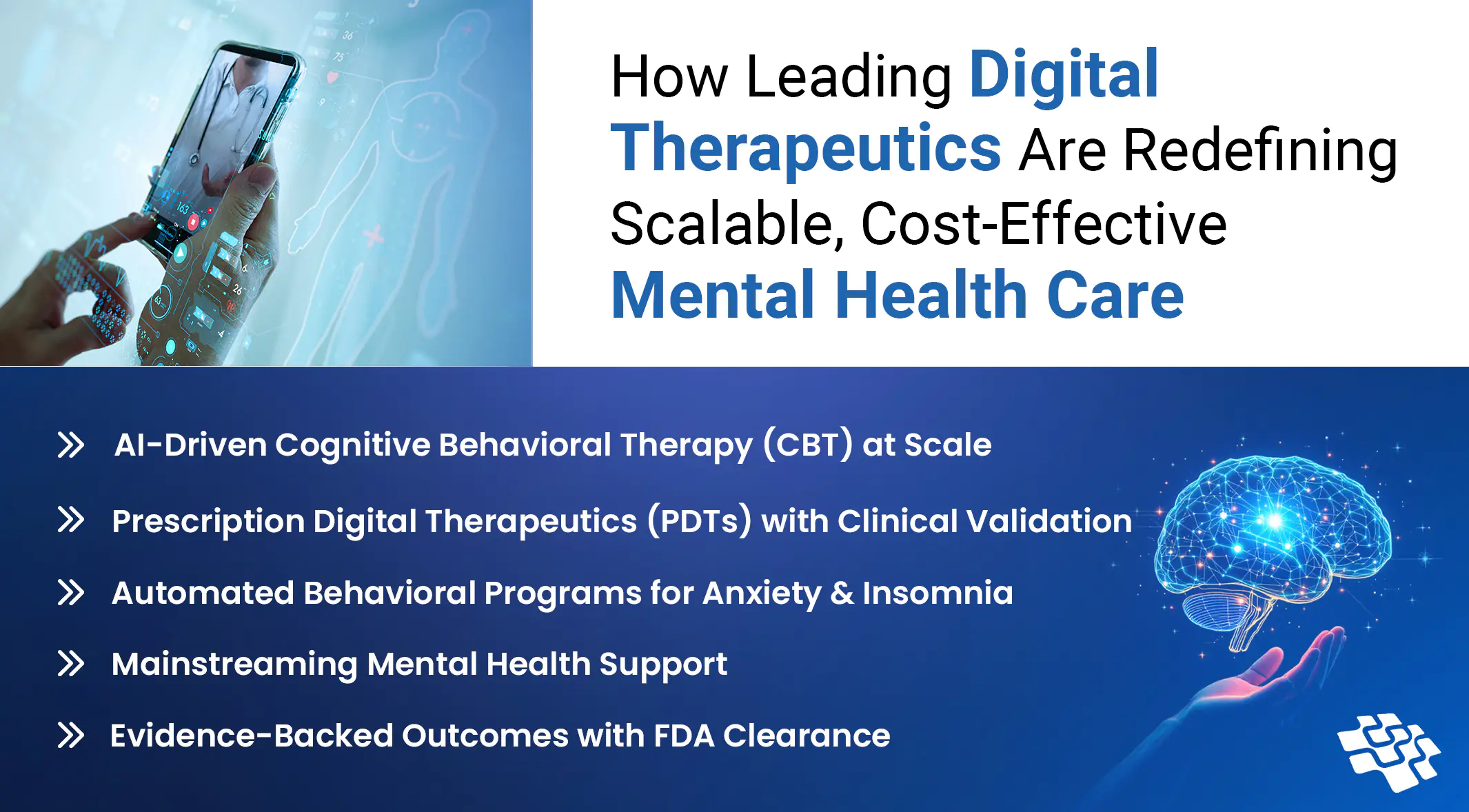
Digital Therapeutics for Mental Health - How Technology is Shaping the Future Well-Being
The field of digital mental health has expanded significantly in the last ten years, covering a wide range of areas such as digital therapeutics for mental health, personalized medicine, telehealth and telemedicine, and mobile health.
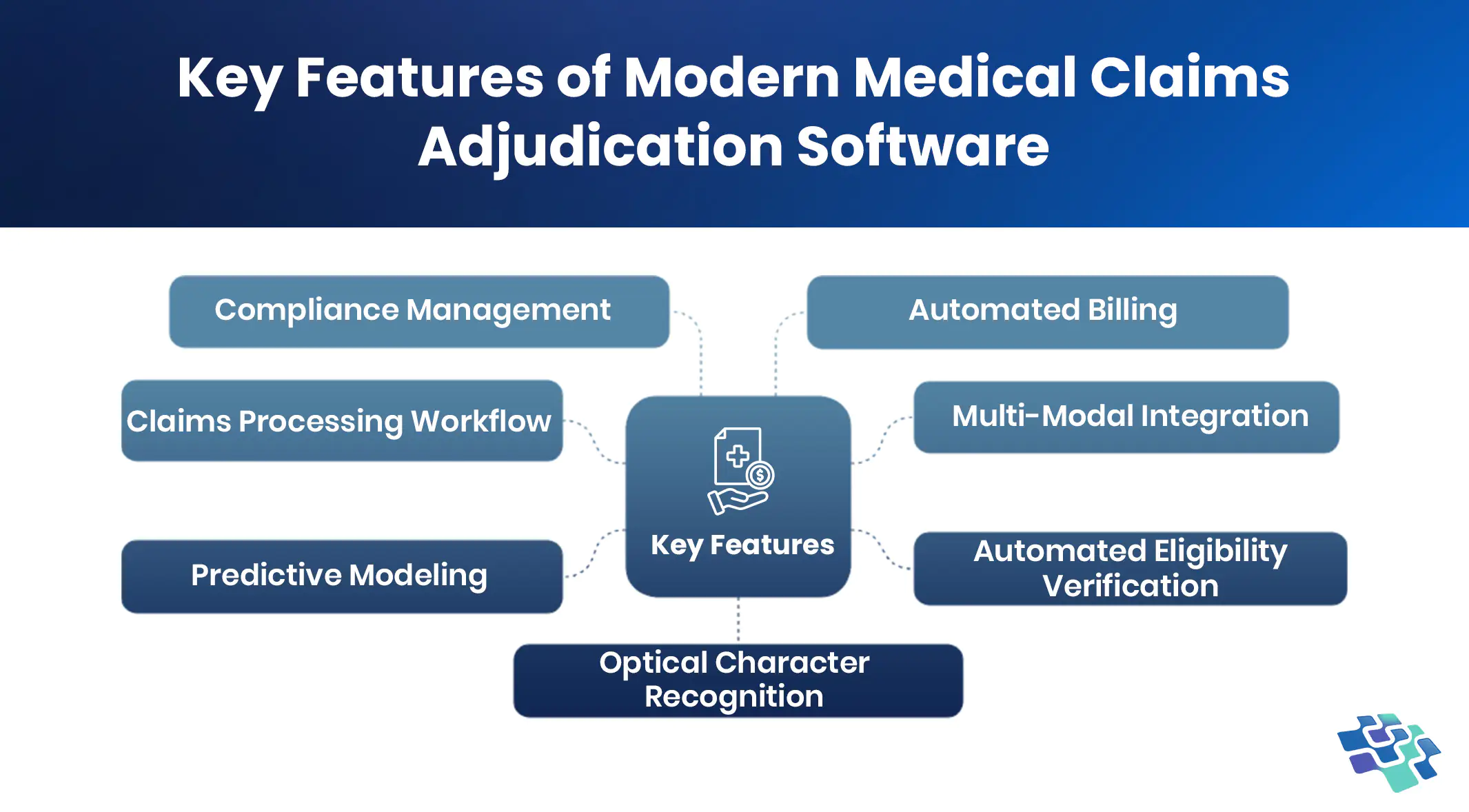
How Augmented Healthcare Claims Adjudication Software Solves the Hidden Crisis in Billing
Is this claim valid? To what extent are we financially responsible? When evaluating medical claims, these are the two main questions that payers try to address.
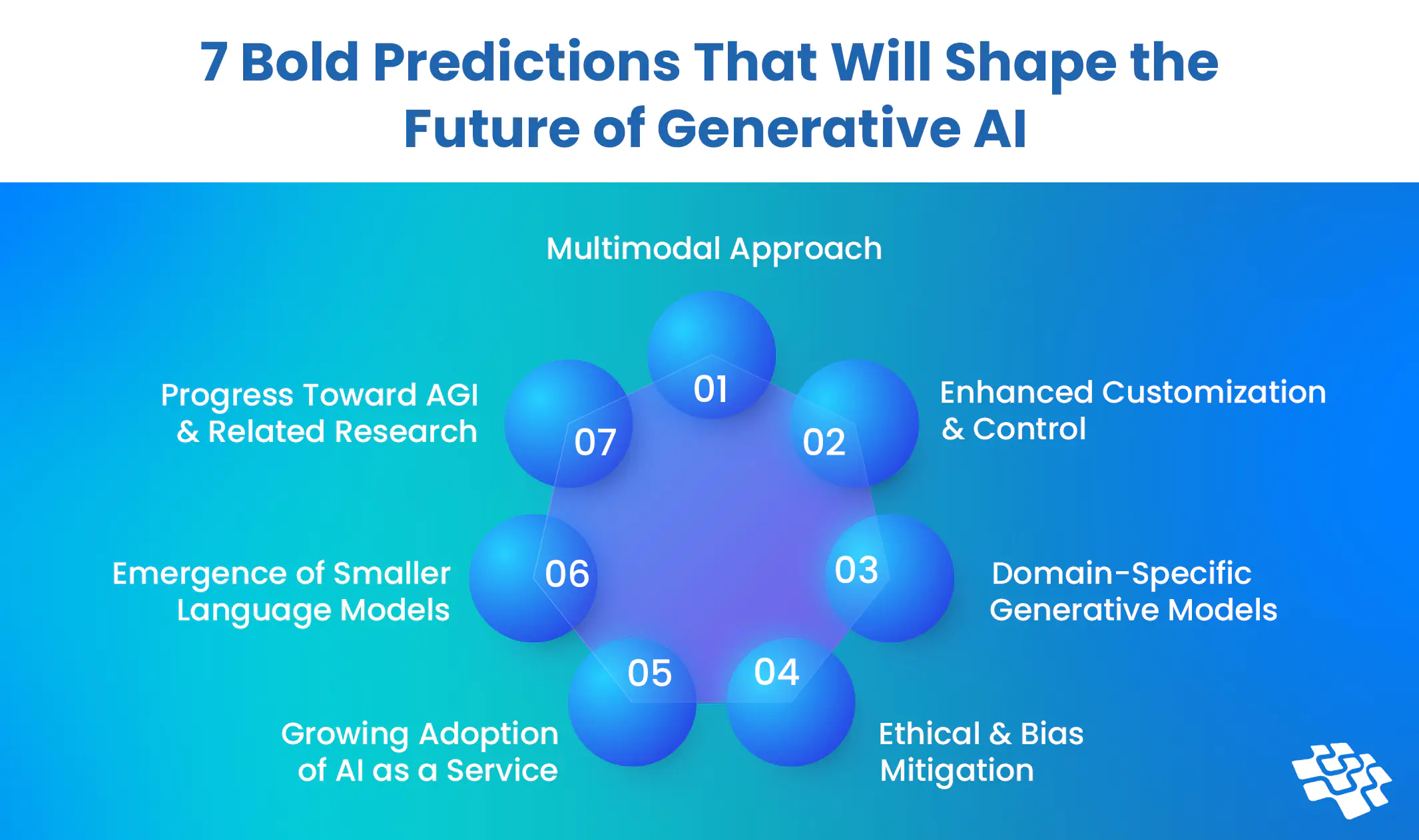
Future of Generative AI: Promises with Continued Research and Development
Although the generative ai and future of work has already grown rapidly, there is still much more to come. According to data, the future of generative AI market is projected to reach a size of around $241 billion by 2033...
Stay In the Know
Get Latest updates and industry insights every month.
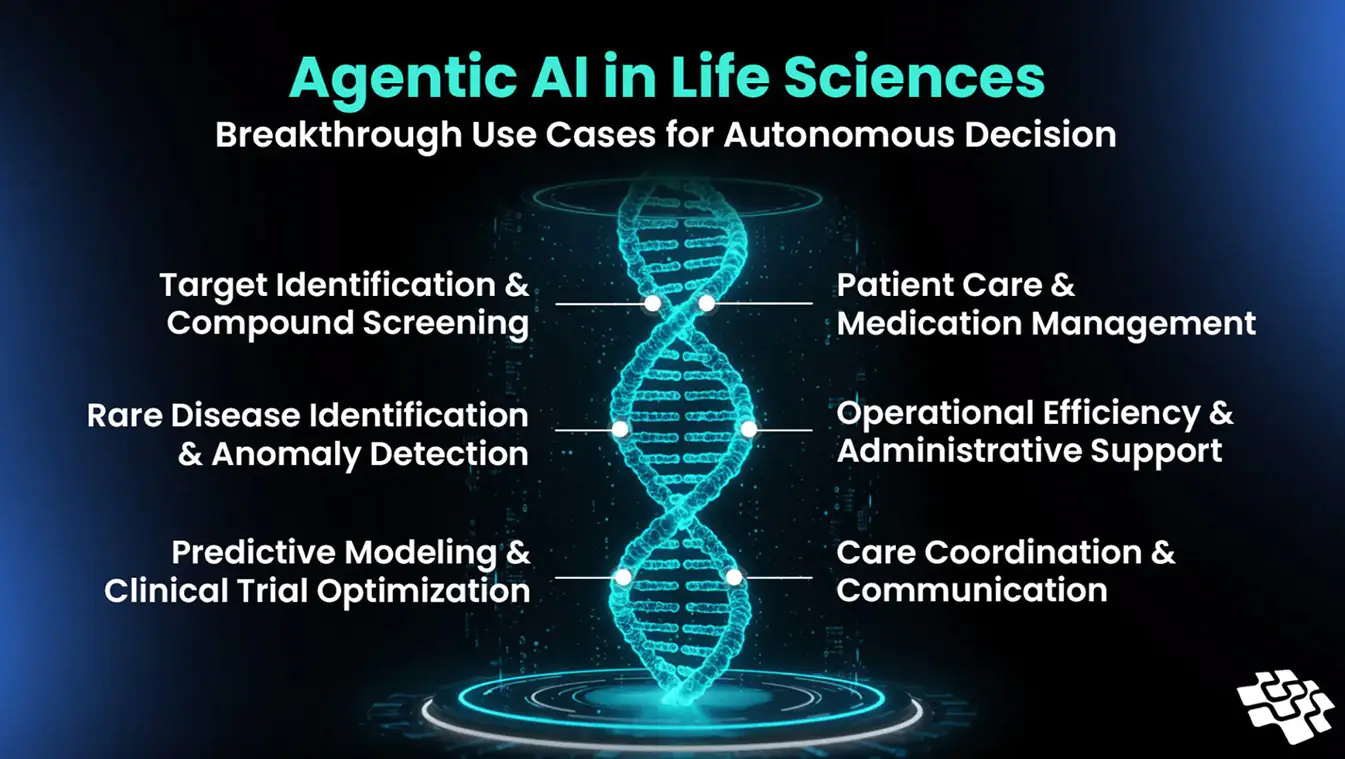 1. Target Identification & Compound Screening
1. Target Identification & Compound Screening